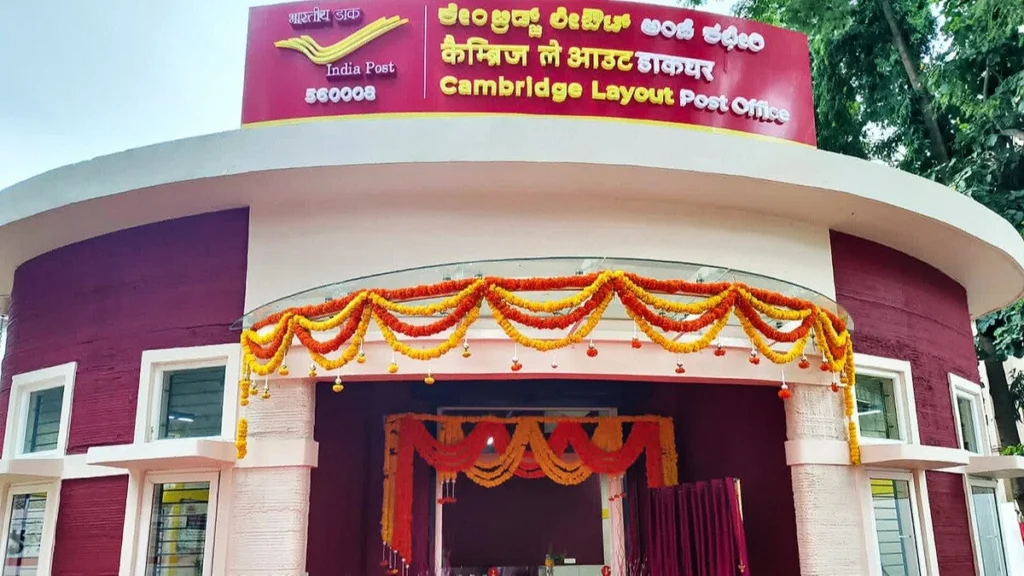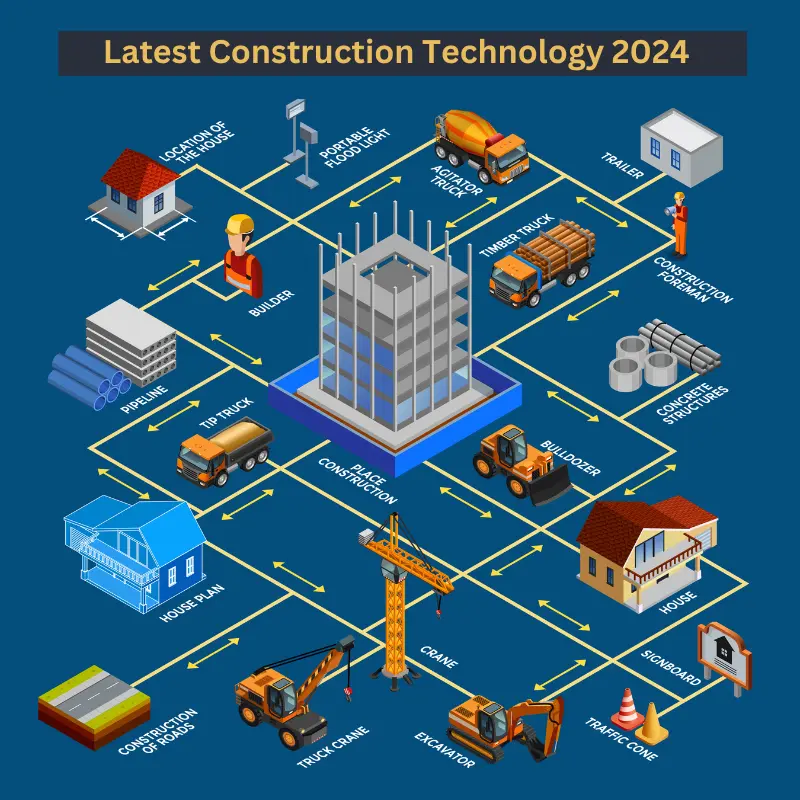Introduction: Embracing the Future of Construction Technology
Table of Contents
Toggle- Introduction: Embracing the Future of Construction Technology
- 11 Latest construction technologies.
- 3D Printing: Redefining Construction with Versatility and Innovation
- Augmented Reality (AR) in Construction
- Internet of Things (IoT): Enhancing Construction through Connectivity and Real-Time Insights
- Robotics: Enhancing Precision and Safety in Construction
- Advanced Materials: Paving the Way for Sustainable and Resilient Construction
- Prefabrication and Modular Construction: Revolutionizing Building Processes
- Blockchain in Construction: Ensuring Transparency and Trust
- Sustainable and Green Building Practices: Building for a Better Future
- Construction Software: Streamlining Project Management and Collaboration
- 5G Technology: Revolutionizing Construction Site Communication
- Laser Scanning and LiDAR: Precision Mapping in Construction
- Conclusion: Shaping the Future of Construction with Advanced Technologies
In the ever-evolving landscape of the construction industry, 2024 marks a pivotal year where technological innovation is not just a luxury but a necessity. As we step into this era, it’s evident that the adoption of advanced construction technologies is revolutionizing the way we build, design, and conceptualize structures. From towering skyscrapers to residential homes, these groundbreaking technologies are reshaping the construction sector, making processes faster, more efficient, and remarkably sustainable.
The significance of this technological revolution cannot be overstated. It’s not just about the implementation of new tools or machines; it’s a complete overhaul of traditional construction methodologies. These innovations are driven by a need to address contemporary challenges such as environmental sustainability, resource efficiency, and the ever-growing demand for complex, yet cost-effective building solutions. As we delve into the depths of these technologies, from 3D printing to the Internet of Things (IoT), and from smart materials to prefabrication, we witness a transformative era where construction is no longer bound by the limits of yesterday’s practices.
This article aims to provide an insightful exploration into the various facets of modern
11 Latest construction technologies.
- 3D Printing
- Augmented Reality (AR)
- Internet of Things (IoT)
- Robotics
- Advanced Materials
- Prefabrication and Modular Construction
- Blockchain
- Sustainable and Green Building Practices
- Construction Software
- 5G Technology
- Laser Scanning and LiDAR
Each section will unveil how these advancements are not just conceptual dreams but practical realities shaping our physical world. As we navigate through each technology, it becomes clear that the future of construction is here, offering opportunities to build smarter, safer, and with a vision that aligns with the needs of our evolving world.
3D Printing: Redefining Construction with Versatility and Innovation
The realm of 3D printing in the construction industry is a vivid testament to technological advancement, offering a blend of versatility, efficiency, and creativity. This method, transcending the traditional boundaries of construction, uses an array of materials ranging from concrete to metals and advanced polymers, each bringing unique properties and possibilities to the table. The capability to print layers upon layers with precise control allows for the creation of intricate and complex designs that were once deemed impossible or highly impractical with conventional construction methods.
A significant advantage of 3D printing lies in its approach to minimizing waste. Traditional construction often leads to excess materials that contribute to environmental strain. In contrast, 3D printing is inherently more sustainable, using only the necessary amount of material, thereby reducing waste and promoting eco-friendly practices. This efficient use of resources is not just an environmental boon but also a cost-effective solution, particularly important in today’s economically conscious world.
The practical applications of 3D printing in construction are not just theoretical but have been realized in various projects globally. For instance, in the Netherlands, a 3D-printed concrete bridge was constructed for cyclists, showcasing the potential of this technology in creating robust and functional structures. Similarly, in Dubai, the world’s first 3D-printed office building stands as a remarkable example of how this technology can be effectively scaled for larger projects. These examples underscore the practicality and scalability of 3D printing in construction, marking it as a cornerstone technology of modern architectural endeavors.
In 2023 Indian given showed green flag for first 3d printed post office
 Source: Indiatoday
Source: Indiatoday
As we continue to explore the potential of 3D printing, it’s clear that this technology is not just a fleeting trend but a pivotal part of the future of construction. It opens up new avenues for architectural expression, efficient resource use, and sustainable development, making it a key player in the construction industry of 2024 and beyond.
Augmented Reality (AR) in Construction
Augmented Reality (AR) in construction is revolutionizing the way architects, engineers, and builders visualize and interact with their projects. By overlaying digital information onto the physical world, AR provides a dynamic and immersive experience, enabling professionals to see the finished product before the first brick is laid. This technology plays a pivotal role in bridging the gap between conceptual designs and physical reality, allowing for a more comprehensive understanding of how a structure will materialize in its environment.
On construction sites, AR is proving invaluable. Workers equipped with AR headsets or mobile devices can access vital information in real-time, directly overlaid onto their field of view. This immediate access to data reduces errors and improves efficiency, ensuring that projects adhere closely to their planned designs. Furthermore, AR enhances training and safety protocols. By simulating real-world scenarios, workers can train in a risk-free environment, gaining experience and knowledge that directly translates to safer, more effective on-site practices.

Augmented Reality (AR) boosts productivity by 32% and slashes task completion times by 46%, as per IBM’s research. This technology is revolutionizing employee training and onboarding, potentially saving U.S. companies $413 billion annually in informal training costs. source: frobes
One notable example of AR in action is in the construction of complex infrastructure projects. For instance, in the construction of a new subway system, AR has been used to overlay the intricate network of tunnels and stations onto the existing cityscape, providing a clear and comprehensive view of the project’s scale and scope. Similarly, AR has been utilized in the restoration of historical buildings, allowing architects to superimpose proposed restorations onto the existing structure to assess compatibility and impact.
Internet of Things (IoT): Enhancing Construction through Connectivity and Real-Time Insights
The integration of the Internet of Things (IoT) in construction marks a significant leap towards smarter, more connected building processes. By embedding sensors and devices throughout construction sites, machinery, and even within the materials themselves, a continuous stream of data is captured and analyzed, providing insights that were once beyond reach. This interconnected network of IoT devices is transforming how construction sites operate, making them more efficient, safe, and responsive.
One of the foremost benefits of IoT in construction is its capacity for real-time monitoring and analytics. By tracking everything from equipment performance to environmental conditions, project managers can make informed, timely decisions, reducing downtime and optimizing workflows. Equipment tracking ensures that machinery is operating at peak efficiency and helps in preventative maintenance, averting costly breakdowns and delays.
Worker safety is another critical area where IoT is making strides. Wearable sensors can monitor vital signs, detect falls, and even ensure that workers are in safe zones, significantly reducing the risk of accidents. In addition, environmental monitoring through IoT helps in maintaining optimal conditions on-site, safeguarding both personnel and materials.
A notable application of IoT in construction is in large-scale projects, like skyscraper construction, where multiple teams and an extensive array of machinery are in operation. Here, IoT enables seamless coordination, ensuring that all elements of the project are synchronized, from the delivery of materials to the precise timing of construction phases.
Robotics: Enhancing Precision and Safety in Construction
The integration of robotics into the construction industry is a game-changer, especially for tasks that require high precision and repetition. Robots, with their ability to work tirelessly and with exacting accuracy, are transforming the way construction tasks are performed. From automated bricklaying to precision cutting and welding, robots are being employed to perform a range of activities that were traditionally labor-intensive and prone to human error.
One of the most significant advantages of using robotics in construction is the enhancement of worker safety. Robots can be deployed in hazardous environments or for tasks that pose risks to human workers, such as high-altitude work or heavy lifting. This not only minimizes the risk of accidents but also improves the overall efficiency of construction projects. Furthermore, robots can work continuously without the need for breaks, thereby speeding up the construction process and ensuring that projects are completed within shorter timeframes.
Real-world examples of robotic technology in construction are increasingly common. For instance, robotic arms are being used for laying bricks with precision, significantly reducing the time required to build walls. Another example is the use of drones for site surveying and monitoring, which allows for real-time data collection and analysis, enhancing project management and decision-making.
Advanced Materials: Paving the Way for Sustainable and Resilient Construction
The development of advanced building construction materials such as self-healing concrete and sustainable composites is playing a pivotal role in modern construction. These innovative materials are not just enhancing the structural integrity of buildings but are also contributing to environmental sustainability and energy efficiency.
Self-healing concrete, for example, contains microorganisms that produce limestone when exposed to air and water, thereby filling cracks and improving the longevity of the material. This reduces maintenance costs and extends the lifespan of structures. Sustainable composites, made from recycled materials or renewable resources, are also gaining traction. These materials are not only environmentally friendly but also offer enhanced performance characteristics such as better insulation and durability.
The impact of these advanced materials on building resilience and energy efficiency is substantial. Buildings constructed with these materials require less energy for heating and cooling, thanks to improved insulation properties. Additionally, the use of eco-friendly building materials contributes to the overall reduction in price an also carbon footprint of construction projects, aligning with global efforts towards sustainability.
Prefabrication and Modular Construction: Revolutionizing Building Processes
Prefabrication and modular construction technology represent a significant shift in the building process, moving much of the construction work from the site to controlled factory environments. This shift brings numerous advantages, including reduced construction times, minimized waste, and enhanced quality control.
In prefabrication, building components such as panels, frames, beams, precast walls and other elements are manufactured off-site and then transported to the construction site for assembly. This method allows for greater precision in the manufacturing process and reduces the impact of external factors like weather on construction timelines. Modular construction takes this a step further by using pre-made modules or units that can be quickly assembled on-site. This approach offers tremendous flexibility and speed in construction, making it particularly suited for projects with tight deadlines or in environments where traditional construction methods are challenging.
A notable benefit of prefabrication and modular construction is the significant reduction in waste. By manufacturing components to exact specifications, there is less excess material generated, contributing to more sustainable construction practices. Additionally, the controlled factory environment ensures higher quality standards, leading to buildings that are structurally sound and aesthetically pleasing.
Blockchain in Construction: Ensuring Transparency and Trust
Blockchain technology is revolutionizing construction project management by enhancing documentation and contract management. Its decentralized and tamper-proof nature ensures unmatched transparency and trust among stakeholders. With blockchain, every transaction, change, or agreement in the construction process is recorded securely and permanently, making it easily verifiable and reducing the chances of disputes. This technology is particularly vital in complex projects involving multiple contractors and suppliers, ensuring everyone is accountable and all actions are traceable. It streamlines processes, from tendering to final delivery, and offers a new level of integrity in managing construction projects.
Sustainable and Green Building Practices: Building for a Better Future
Sustainable design and construction are pivotal in today’s construction industry, aiming to minimize environmental impact while creating healthier living spaces. Certifications like LEED (Leadership in Energy and Environmental Design) and BREEAM (Building Research Establishment Environmental Assessment Method) set global standards for green building practices. These include energy-efficient designs, use of renewable energy, and eco-friendly materials, significantly reducing a building’s carbon footprint. Adopting these practices not only benefits the environment but also enhances the building’s value and reduces operational costs, making it a win-win for builders, occupants, and the planet.
Construction Software: Streamlining Project Management and Collaboration
Construction software tools have become indispensable in modern project management, offering solutions for scheduling, budgeting, and team collaboration. These tools facilitate efficient construction cost planning and efficient use of skilled and unskilled labor , construction Material Management, forecasting project delays ensuring projects stay on track and within budget.
Features like real-time updates, cloud-based collaboration, and integrated workflows allow for seamless communication among teams, regardless of location. This results in improved decision-making, resource management, and overall project control. From small-scale renovations to large infrastructure projects, construction software is transforming the way projects are managed, making them more efficient and less prone to errors.
5G Technology: Revolutionizing Construction Site Communication
The advent of 5G technology in construction is a game-changer, particularly in enhancing communication and data transfer. With its high-speed, low-latency capabilities, 5G is essential for real-time data sharing and collaboration on construction sites. This next-generation network plays a crucial role in the effective deployment of Internet of Things (IoT) devices, drones, and augmented reality (AR)/virtual reality (VR) applications. For IoT, 5G enables a seamless and continuous flow of data from various sensors and devices, facilitating better monitoring and management of resources.
In the case of drones, 5G improves the control and transmission of high-resolution imagery, essential for site inspections and progress tracking. AR and VR applications, empowered by 5G, offer immersive and interactive experiences for design visualization and project planning, significantly enhancing accuracy and efficiency in construction processes. This synergy of 5G with cutting-edge technologies is setting new standards in construction, leading to smarter, faster, and more efficient project execution.
Laser Scanning and LiDAR: Precision Mapping in Construction
Laser scanning and LiDAR (Light Detection and Ranging) technologies have become pivotal in modern construction for their ability to create highly accurate 3D models of buildings and landscapes. These technologies are instrumental in conducting comprehensive site surveys, offering detailed topographical and structural data that is critical for planning and design.
By generating precise 3D representations, laser scanning and LiDAR enable architects and engineers to visualize and assess the real-world conditions of a construction site, leading to better-informed decisions and designs. One of their key applications is in quality control, where they ensure that the ongoing construction aligns with the planned designs, thereby minimizing errors.
Additionally, these technologies are invaluable for clash detection, identifying potential issues in overlapping structures or systems early in the construction process. This preemptive identification allows for timely resolutions, avoiding costly and time-consuming reworks. The accuracy and efficiency brought by laser scanning and LiDAR are reshaping construction methodologies, leading to enhanced quality, reduced waste, and streamlined project timelines.
Conclusion: Shaping the Future of Construction with Advanced Technologies
As we explore the remarkable potential of these advanced technologies, it’s evident that the construction industry stands on the brink of a transformative era. The integration of 3D printing, augmented reality, IoT, robotics, advanced materials, prefabrication, modular construction, blockchain, sustainable practices, construction software, 5G technology, and laser scanning/LiDAR is not just an incremental change but a complete paradigm shift. These technologies collectively address the current challenges in construction, offering solutions that are not only innovative but also sustainable and efficient.
The future outlook for the construction industry, powered by these technologies, is immensely promising. We are looking at a future where buildings are not only constructed faster and more safely but also with a greater focus on sustainability and precision. The adoption of these technologies means reduced waste, enhanced energy efficiency, and buildings that are both environmentally responsible and architecturally groundbreaking.
As we move forward, the role of these technologies in overcoming the traditional constraints of construction will become increasingly significant. The industry is evolving towards smarter, more connected, and sustainable practices, paving the way for a future where construction is synonymous with innovation and excellence. The journey towards this future is already underway, and it promises to redefine our built environment for the better




